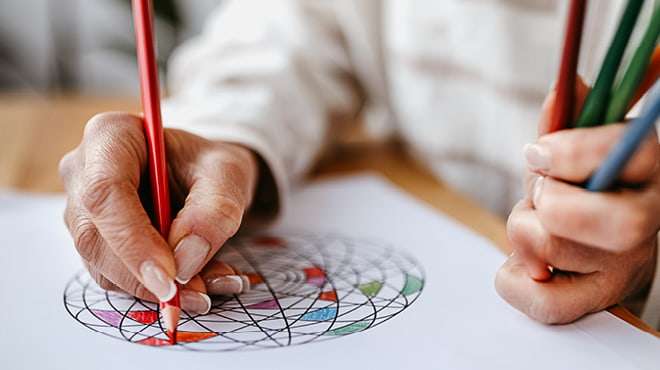What used to be known as a simple, fun activity for kids now is a tool for practicing good mental health. Coloring has increased in popularity recently, especially for adults.
While children’s coloring books feature cartoon characters and simple designs, adult coloring books have intricate patterns of flowers, artwork, mandalas or animals. Books are available for purchase, and you can print free coloring pages online. For people who prefer a digital version, many coloring apps are available for mobile devices.
But what makes adult coloring so popular?
Coloring can improve your health by:
Promoting mindfulness
Coloring can help you be more mindful. Mindfulness is the ability to focus and stay in the moment.
For example, because you’re focusing on color choice and staying inside the lines, you’re only thinking about the present moment. You can shut off the noise around you, and give your mind the gift of focusing on the movements, sensations and emotions of your present moment.
Practice being nonjudgmental as you go through the task with no expectations — just being in the moment. If your mind wanders, which is normal, gently return to what you are experiencing right now. While coloring, you use the parts of your brain that enhance focus and concentration. It gives you the opportunity to disconnect from stressful thoughts.
Relieving stress
Coloring is a healthy way to relieve stress. It calms the brain and helps your body relax. This can improve sleep and fatigue while decreasing body aches, heart rate, respiration, and feelings of depression and anxiety.
Although coloring isn’t the ultimate cure for stress and anxiety, sitting down for a long coloring session holds great value. As you color, pay attention to your breathing rhythm, ensuring steady, full breaths from your diaphragm, and tune into your heart rate periodically if you can.
Embracing the imperfect
There’s no right or wrong way to color. Coloring is a noncompetitive activity, so there isn’t pressure to “level up,” win a prize or beat the clock. You can color for as long or as little time as you want. You don’t need to finish a picture in one sitting.
Try to let go of judgments or expectations and enjoy the simple beauty of coloring. It doesn’t matter if your picture is neat or messy. The only thing that matters is if you found enjoyment and relaxation while coloring.
Other ways to relieve stress
Some people don’t find coloring to be relaxing or enjoyable, especially those who didn’t like to color as a child. That’s OK.
Other fun ways to relieve stress include:
- Spend time with a four-legged friend.
It’s no secret that pets make us happy. Their love is unconditional, they are always happy to see us, and they’re adorable. Spend some quality time with a pet, or volunteer at an animal shelter if you don’t have pets of your own. - Crack open a book.
Reading is a great way to wind down. Like coloring, it helps you lose yourself in the moment and forget about your work or other stressors. - Massage your earlobes.
Massaging the pressure points in your earlobes brings on a calming, relaxing sensation over your body. Do this for a few minutes, and you may start to feel some relief. - Bust a move.
Breaking out your best dance moves along with your favorite song can be therapeutic for many people. If you’re dancing throughout most of the song, you also can say you snuck in some exercise. - Take a deep breath.
Deep breathing is a great way to reduce your body’s response to perceived threats. Breathe in through your nose for five seconds and hold for two seconds. Then release your breath through your mouth for five seconds.
Joel Bobby is a licensed independent clinical social worker in Psychiatry & Psychology in Austin, Minnesota.

Think spending hours coloring is only a childhood pastime? Think again!
The adult coloring book trend has spread nationwide, with some even popping up on bestseller lists. With the countless health benefits of coloring for adults, it might be time to pull out the crayons, colored pencils and markers!
REDUCE STRESS AND ANXIETY
Coloring has the ability to relax the fear center of your brain, the amygdala. It induces the same state as meditating by reducing the thoughts of a restless mind. This generates mindfulness and quietness, which allows your mind to get some rest after a long day at work.
IMPROVE MOTOR SKILLS AND VISION
Coloring goes beyond being a fun activity for relaxation. It requires the two hemispheres of the brain to communicate. While logic helps us stay inside the lines, choosing colors generates a creative thought process.
IMPROVE SLEEP
We know we get a better night’s sleep when avoiding engaging with electronics at night, because exposure to the emitted light reduces your levels of the sleep hormone, melatonin. Coloring is a relaxing and electronic-free bedtime ritual that won’t disturb your level of melatonin.
IMPROVE FOCUS
Coloring requires you to focus, but not so much that it’s stressful. It opens up your frontal lobe, which controls organizing and problem solving, and allows you to put everything else aside and live in the moment, generating focus.
You don’t have to be an expert artist to color! If you’re looking for an uplifting way to unwind after a stressful day at work, coloring will surely do the trick. Pick something that you like and color it however you like!
Adult coloring books have flooded shelves everywhere in the last few years. From grocery stores to your favorite online retailer, these books — with their empty patterns of mandalas, animals and floral designs — seem to be everywhere. But what makes them so popular?
Advertising Policy
Cleveland Clinic is a non-profit academic medical center. Advertising on our site helps support our mission. We do not endorse non-Cleveland Clinic products or services. Policy
Many books tout the benefits of coloring — a thing kiddos have known for ages. Coloring can help you channel your inner artist, de-stress and bring a sense of peace. But is there truly a benefit to coloring for adults? And what does this pastime do to our brains to bring about such pleasure and calm?
According to clinical psychologist Scott M. Bea, PsyD, it has everything to do with refocusing our attention.
“Adult coloring requires modest attention focused outside of self-awareness, Dr. Bea says. “It’s a simple activity that takes us outside ourselves in the same way, cutting the lawn, knitting or taking a Sunday drive can all be relaxing.”
What does adult coloring do to relax people?
Dr. Bea cites three reasons adult coloring can be calming:
- Attention flows away from ourselves. A simple act, such as coloring, takes your attention away from yourself (and those things that are stressing you out!) and onto the present-moment event. “In this way, it is very much like a meditative exercise,” Dr. Bea says.
- It relaxes the brain. When thoughts are focused on this simple activity, your brain tends to relax. “You’re not disturbed by your own thoughts and appraisals,” he says. “The difficulties of life evaporate from your awareness, and both your body and your brain may find this rewarding.”
- Low stakes make it pleasurable. Go ahead: color outside the lines! The outcome of coloring isn’t predictable or prescriptive. It can be as neat — or as messy — as you choose, and this is one of its relaxing perks. “It is hard to screw up coloring, and, even if you do, there is no real consequence. Adult coloring can be a wonderful escape, rather than a demanding test of our capacities,” he adds.
Why does it help some people but not others?
Adult coloring doesn’t relax everyone. Whether or not you enjoy coloring depends a lot on your prior experiences. Dr. Bea suspects that if you enjoyed coloring as a child, you likely will enjoy it as an adult.
“Adults typically choose forms of activities they loved as children for their adult recreations,” he says.
Is there research to support it as a form of relaxation?
Research on adult coloring specifically is limited, as it has risen in popularity relatively recently. However art therapy has been used for many years with much success.
In a 2006 study, researchers found that mindfulness art therapy for women with cancer helped to significantly decrease the symptoms of physical and emotional distress during their treatment. Art therapy has also been helpful to people coping with other conditions, including depression, anxiety, addictions and trauma.
In a more recent study, researchers evaluated the effectiveness of coloring a complex geometric design, like a mandala, on reducing anxiety with a group of undergraduate students. The results showed a decrease in anxiety levels for the students and suggested the practice created a sort of meditative state that is beneficial for reducing anxiety.
“While adult coloring may differ slightly from mindfulness art therapy, I suspect the adult coloring would yield similar results. It is likely that its therapeutic benefits would be similar to listening to a person’s favorite music,” Dr. Bea says.
Why has this become popular now?
Having hobbies to help de-stress is nothing new, whether people like to golf, cook, build model airplanes or put together scrap books.
But with the current state of daily life with COVID-19, and so many uncertainties looming in the distance, coloring might just be the ticket to help you unwind and re-center.
“We have a very stress-inducing culture, and I think individuals are always seeking new ways to reduce tension, restore feelings of well-being, and reduce the toll that our stressful lives take on our health,” Dr. Bea says.




